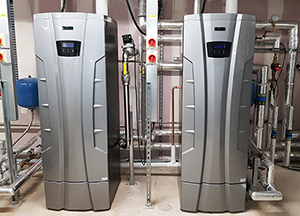Sustainable & Cost-Effective Hot Water For Care

Care facilities typically exhibit significant, but varied, hot water and heating usage patterns, which contributes to the current 40% tally of UK greenhouse gas emissions generated by the built environment.
To help achieve climate-neutral building stock by 2050 the industry is being challenged to reduce operational energy use over all other measures. By increasing the use of renewable energy supply and prioritising on-site renewable energy sources the hope it to reduce both carbon and bills.
Sustainability comes with a cost. Whether in the form of new build projects or, and far more likely, the refurbishment of existing yet ageing facilities, understanding the necessary capital investment, operational savings and payback periods is going to be key.
Addressing the efficiency of domestic hot water (DHW) systems - whether through the implementation of heat pumps, solar thermal, direct electric water heating or even simple modernisation of existing gas appliances - helps care facilities meet sustainability goals in a practical and cost-effective manner. It also delivers improved year-round conditions for staff and clients in care, providing access to spaces better suited to delivering medical care and assisted living.
Far too often, healthcare hot water systems suffer from poor application design leaving them oversized and demanding more appliances, ancillaries, space and complex installation than necessary. Inefficient and less environmentally friendly, such systems will prove more costly to build and operate for their entire lifespan.
Oversizing inherently comes from a lack of understanding of different types of hot water system. When faced with healthcare DHW systems that have too many variables and decisions on diversity, sizing programmes will oversize to prevent perceived hot water problems.
Understanding the application demands - from intense peak/all storage to continuous demand/all power - is critical when sizing a dynamic hot water system. At Adveco, our dedicated application design team provide accurate, bespoke sizing, for both new build and refurbishment projects. Once correctly sized, we can recommend, supply, commission, and service the optimal appliances whether they be gas, electric or a mixed hybrid approach that incorporates low carbon and renewable technologies such as solar thermal and heat pumps. This is the best way of ensuring hot water demands are met in the most cost-effective and sustainable manner.
The Path To Lower Carbon Hot Water
The design of applications for commercial hot water systems has remained remarkably consistent and if a building is more than ten years old it is going to be built around either a condensing gas water heater or an indirect water heater and boiler. Gas-based hot water systems were specified because this was the most cost-effective and cleanest way of producing high-temperature hot water.In the past decade though we have seen a seismic shift in thinking driven by the wide acceptance of the harmful effects of global warming and a need to address its root causes.
To decarbonise DHW applications there are currently two core technology options, air source heat pumps (ASHP) or solar thermal. Although both can provide low or zero-carbon heat, neither can fully replace an existing water heating system. Since commercial DHW systems must operate in excess of60°C to prevent the threat of legionella, ASHP efficiency, designed to work with lower temperatures, rapidly falls away limiting supply. Solar thermal on the other hand is limited by the sun’s availability across the year, and it is worth remembering will not provide space heating either. However, both can be used as a source of preheat to reduce energy use. Both will work equally well with after heat provided by gas or electric water heating.
For buildings already on gas and that rely on large amounts of DHW - a large proportion of current UK healthcare properties - solar preheat is the preferable option. Depending on the site and energy consumption habits, solar thermal will typically provide around 30% of the hot water demand.
For new build properties, the expectation is for specification to default to a mixture of heat pumps and direct electric afterheat. For new healthcare builds, consultants are specifying for greater electrical load to account for the additional power demands. This though is a costly addition for large legacy properties wanting to introduce electrification for hot water and heating. For smaller hot water demands in new builds, where the need for a gas supply has been avoided, that additional cost may be acceptable. But if electrical costs need to be offset then the numbers are now looking really favourable for adopting solar thermal for either electric only or existing gas-based strategies. A much more rapid return on investment is now achievable and the property gains undisputed carbon and cost savings.
Shaping the future of care properties today
A hybrid approach, which encompasses some or all these technologies, is unavoidable for commercial projects and is the most sensible, practical, and cost-effective option. Whether all-electric or using gas after heat, healthcare organisations can actively drive sustainability and retain control of operational expenditure for decades to come.
While we must all recognise the importance of excluding fossil fuels from future commercial systems, consideration should be given to the expected adoption of greener hydrogen toward the end of this decade. The Government expects this will be a core component for meeting net zero at a national level, especially for buildings with higher energy demands. It is therefore worth confirming whether existing gas water heaters or replacement units will accommodate the proposed 20% hydrogen blend that would begin the decarbonisation of the gas grid. With hydrogen policy to be confirmed in 2026, retaining gas in existing commercial buildings keeps options open and future-proofs a building for other emerging heating technologies.
The drive to adopt sustainable and renewable technology is encouraging, but there currently remains no single technology that supplies all the answers for commercial scale projects. Whether a new build or refurbishment project, the physical limitations of a site will always propel or preclude certain options. A practical, open minded approach to driving cleaner heat through a mix of replacement gas and renewables is what will really propel buildings towards 2050 net zero targets while also delivering considerable benefits to those using these buildings.
https://adveco.co/sectors/healthcare/





